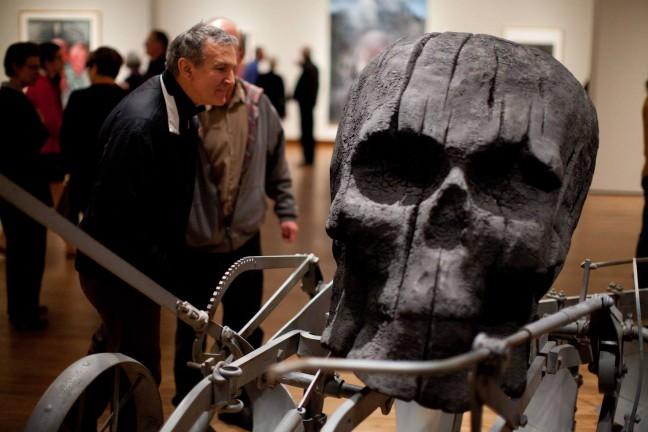Next to the 60s-era concrete jungle that is the Humanities Building and the seemingly perpetual presence of skid loaders and orange plastic fencing on Library Mall, the Chazen Museum of Art stands pristine in the mid-summer sunshine. This bastion of high culture hosts 10 to 12 exhibitions yearly and currently features Jim Dine’s series of skull-themed artwork “I knew him.,” as well as a collection of photographs called “A Passion for Photography,” which were donated by John W. and Carol L.H. Green.
“I knew him.” is a provocative title. It reminds visitors that the skull does not simply represent someone or something; it literally is someone. It is the eyes they saw with, mouth they spoke with, ears they heard with and face that their friends and family recognized throughout their life. The title “I knew him.” asks viewers to see humanity in the skull rather than a fashionable image or a symbol of death and danger.
The most noticeable piece in the collection courts attention through its placement. If you’ve been on campus during the summer, you have probably noticed a fairly large skull balanced on top of vertically aligned pallets. The jarring nature of this sculpture (which was built in 1989 and is called “Ancient Fishing”) juxtaposed with the sophisticated atmosphere of the Chazen is an appropriate representation of the collection. Dine’s work is, ironically, full of unrestrained brightness and color and features many paintings with skulls beside or within the shape of a heart. It involves a very intentional selection of shapes but throws them into a melee of sporadic brushstrokes, ill-defined boundaries and an unending barrage of color.
In addition to the outdoor sculpture, there is a much larger, slightly similar 3-D piece in the middle of the exhibit’s main room. There is no label on the sculpture, but, in an interview with the director of the Chazen, Dine informs us that it is called “The Plow” (made in 1997). The skull in this sculpture was cast from the same mold as the one in “Ancient Fishing.” This one, however, was burnt with a torch before being placed onto an archaic plow that Dine described as “a found object.”
This exhibit also includes several walls full of photogravure, a process of printing photos that allows for impressive size and quality. There is a startling amount of realism portrayed in these photos through the use of high-resolution images and the occasional inclusion of the artist himself. These are a great compliment to Dine’s larger, more readily displayed artwork, and they further elaborate on the human element of the collection.
On the second floor of the museum, visitors will find another group of photos that are also very artful but much less connected to one another. “A Passion for Photography” is a collection that includes depictions of some of the most famous artists who have ever lived. Pablo Picasso, Jackson Pollack and Henri Matisse line the walls of the gallery and share a space with Marilyn Monroe, Albert Einstein and unnamed residents of Uzbekistan, Brazil and Yemen.
While the star power of these almost mythical figures from art and pop culture is intriguing, how they are shown in the photos and how they interact with their environments is even more engaging. Picasso, Pollack and Matisse are all seen either in their workspace or with their art. Pollack is shown in front of a seemingly infinite number of paint cans that one can imagine were all— and always — part of his creative process.
In the case of Picasso, the photos give viewers a chance to see the man who inspired a revolution in visual art and creative thinking. A short, bald man, Picasso hardly seems to live up to the legend assigned to him. When seeing him standing next to his works, however, it is impossible to separate him from the thousands of pieces he created and the infinite number of artists he influenced throughout his lifetime and afterward.
“’I knew him.’ Jim Dine skulls, 1982-2000” and “A Passion for Photography: The John W. and Carol L.H. Green Collection” will be on display at the Chazen Museum of Art until August 17, 2014.


